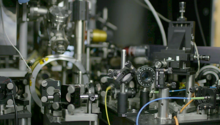Mikkel Andersen (physicist)
Mikkel F. Andersen is a physicist, Associate Professor at the University of Otago, and an investigator at the Dodd-Walls Centre in Dunedin, New Zealand. His research deals with ways to capture fast-moving atoms.
Mikkel Andersen | |
|---|---|
.png) | |
| Alma mater | Weizmann Institute of Science |
| Scientific career | |
| Fields | Quantum mechanics |
| Institutions | |
Education

Born in Denmark, Anderson did his MSc in physics and astronomy at Aarhus University, graduating in 1999. He then studied laser cooling at the Weizmann Institute of Science in Rehovot, Israel, finishing his PhD in the physics of complex systems in 2004.[1] From 2004 to 2006 he did a post-doc at the National Institute of Standards and Technology, studying laser cooling with Nobel Laureate William D. Phillips, inventor of the Zeeman slower.[1] After a year at New York University, he moved to Dunedin and joined the University of Otago Physics Department as a lecturer, rising to Associate Professor.[1]
Areas of research

One of Andersen's projects is looking at ways to create robust sources of quantum entanglement, a process which usually only works at ultra-cold temperatures.[2] Laser cooling – shining a laser in the opposite direction an atom is travelling, slowing it and reducing its temperature to one millionth of a degree above absolute zero – puts an atom in a quantum state and allows it to be manipulated.[1] This requires a hyper-evacuated vacuum chamber with a pressure of almost zero, an apparatus about the size of a toaster.[1][3]
Andersen's team first isolated, captured, and photographed a rubidium atom in 2010.[4] Now individual pairs of atoms can then be held in place with lasers – "optical tweezers" – and observed colliding and entangling.[2][3] Previously these processes were examined statistically through experiments on large numbers of atoms, but combining multiple atoms increased the possibility of chemical reactions between them.[5] More recent experiments led by postdoc Marvin Weyland have assembled three individual atoms into a molecule and measured the energy released in the process.[3][6] This research has implications for quantum computer development,[1] constructing moecules at the atomic scale, and the theoretical underpinnings of molecular assembly.[3]
Another project is the development of an atomic gravimeter, smaller and cheaper than existing models, for measuring local fluctuations in the Earth's gravitational field.[7]
Selected publications
- Reynolds, L. A.; Schwartz, E.; Ebling, U.; Weyland, M.; Brand, J.; Andersen, M. F. (18 February 2020). "Direct Measurements of Collisional Dynamics in Cold Atom Triads". Physical Review Letters. 124 (7): 073401. doi:10.1103/PhysRevLett.124.073401.
- Sompet, Pimonpan; Szigeti, Stuart S.; Schwartz, Eyal; Bradley, Ashton S.; Andersen, Mikkel F. (2019). "Thermally robust spin correlations between two 85Rb atoms in an optical microtrap". Nature Communications. 10 (1): 1889. doi:10.1038/s41467-019-09420-6.
- Chai, Shijie; Fekete, Julia; Andersen, Mikkel F. (10 December 2018). "Measuring the local gravitational field using survival resonances in a dissipatively driven atom-optics system". Physical Review A. 98 (6): 063614. doi:10.1103/PhysRevA.98.063614. ISSN 2469-9926.
- Grünzweig, T.; Hilliard, A.; McGovern, M.; Andersen, M. F. (2010). "Near-deterministic preparation of a single atom in an optical microtrap". Nature Physics. 6 (12): 951–954. doi:10.1038/nphys1778.</ref>
- Ryu, C.; Andersen, M.; Cladé, P.; Natarajan, Vasant; Helmerson, K.; Phillips, W. (28 December 2007). "Observation of Persistent Flow of a Bose-Einstein Condensate in a Toroidal Trap". Physical Review Letters. 99 (26): 260401. doi:10.1103/PhysRevLett.99.260401.
- Andersen, M.; Ryu, C.; Cladé, Pierre; Natarajan, Vasant; Vaziri, A.; Helmerson, K.; Phillips, W. (26 October 2006). "Quantized Rotation of Atoms from Photons with Orbital Angular Momentum". Physical Review Letters. 97 (17): 170406. doi:10.1103/PhysRevLett.97.170406.
References
- Frederick, Guy (March 2018). "Mikkel Andersen". North & South.
- Morton, Jamie (31 January 2019). "'Spooky' science will supercharge tomorrow's computers". The New Zealand Herald. Retrieved 15 July 2020.
- Dodd-Walls Centre (20 February 2020). "Juggling three atoms". Retrieved 21 July 2020.
- Loughrey, David (9 March 2017). "Otago scientists control atom". Otago Daily Times. Retrieved 29 July 2020.
- Gibb, John (25 April 2019). "Atom by atom, scientists learning to build a new technology". Otago Daily Times. Retrieved 29 July 2020.
- University of Otago (20 February 2020). "Otago physicists grab individual atoms in ground-breaking experiment". University of Otago. Retrieved 28 July 2020.
- Gibb, John (22 December 2018). "A matter of some gravity". Otago Daily Times. Retrieved 29 July 2020.
External links
| Wikimedia Commons has media related to Mikkel Andersen (physicist). |